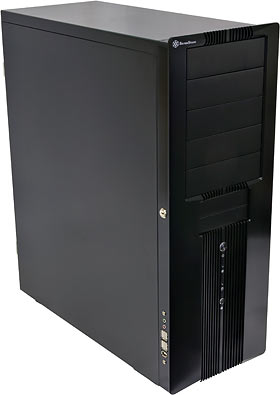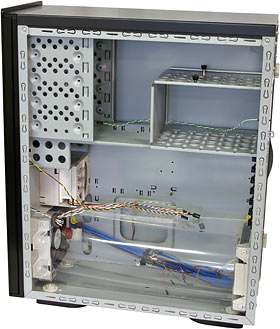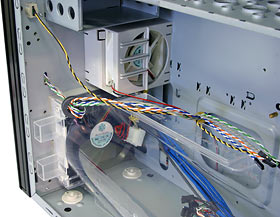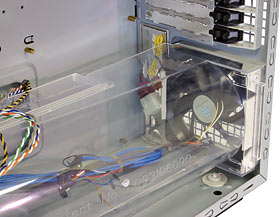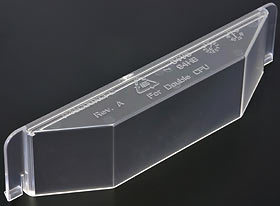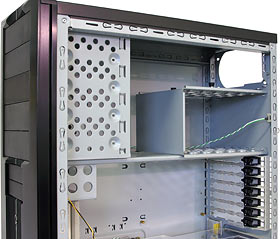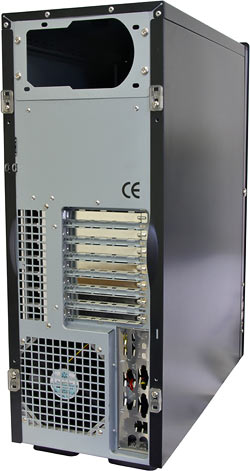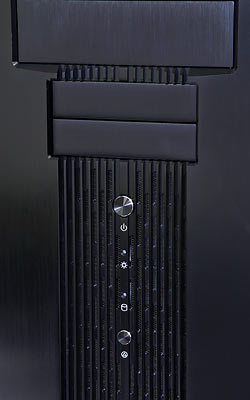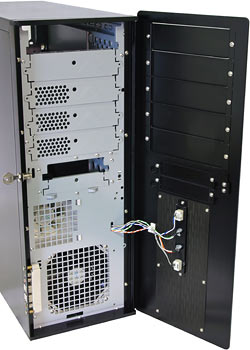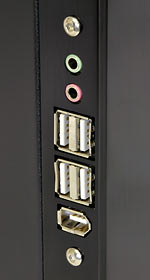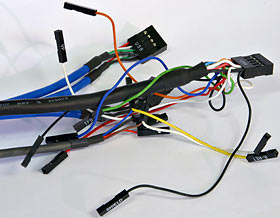
SilverStone TJ06 PC case
Review date: 14 February 2005. Last modified 03-Dec-2011.
The BTX form factor hasn't, as yet, made quite the splash Intel hoped, way back in 2003.
BTX was supposed to be mainstream by now, but (among other things) the fact that the full BTX spec requires motherboards that won't work with Athlon 64s (not, probably, actually something Intel planned) has consigned BTX to the sidelines.
Which is a shame, because BTX offers a solution to at one real problem for most modern PCs - keeping cool without making a deafening noise.
Both the Pentium 4 and the Athlon 64 are toasty little blighters. Even if you haven't bought one of the overpriced Extreme Edition or FX-FiftyWhatever versions, you're still talking more than a hundred watts TDP for a 3.2 or 3.4GHz P4 at stock speed, and a nominal 89 watts for various A64s. Add at least 20 watts from any half-decent current video card running in 3D mode, and maybe that much again from the rest of the motherboard including the RAM and expansion cards, and a few watts from each hard drive and optical drive when they're spinning, and it's not at all hard for a modern PC to be pumping out 150 watts of heat. Roll with the overclocking crew, yo, and 200 watts is thoroughly doable.
Get yourself 150 watts worth of incandescent light bulbs, put 'em in an empty computer case with no fans and turn 'em on, and see how long it takes before the outside of the case is too hot to keep your hand on. The exact same thing will happen to a PC whose ventilation fans fail (and, amazingly enough, it'll probably survive the experience; chips that heat up slowly will cause a computer to crash before they get hot enough to die).
When the ATX standard was introduced, mavericks who pushed their FSB all the way to 83MHz might have been able to get their Pentium to output 20 watts. The rest of the stuff inside the case wouldn't be likely to double that - it'd be three years before the first 3D game card came out.
Most PCs were, therefore, perfectly adequately cooled by the single fan in the power supply; one more intake fan was overkill, unless you had a great big drive array or something. The actual airflow path was, and is, quite inefficient - swirls and eddies, and too much air flowing over things like the RAM that aren't actually very hot. That didn't matter when there was only 30 or so watts to get rid of; it matters much more now.
The usual way to make an ATX case that runs cool is to infest it with regular fans, or use a single huge one. The airflow's still highly chaotic, but there's just so darn much of it that the computer can't help but work.
Both of these strategies, though, create a lot of noise - and waste several more watts of power in making that noise and stirring the air around pointlessly. These problems are unavoidable with ATX machines, which just have fans in holes in the box. BTX machines have ducted cooling that delivers air where it's needed, solving the problem - but because BTX hasn't taken off yet, people who want to buy a regular white-box clone, or assemble their own system, can't have such a machine.
Here's the stopgap.
It's SilverStone's TJ06. It's a full tower case, 566 by 205 by 474mm (22.3 by 8.1 by 18.7 inches) in size, and it accepts ATX (and Extended ATX, and of course also microATX and FlexATX) motherboards.
It's got the weight of a full tower, too; 11 kilograms (24.25 pounds), without a power supply, because its frame is steel. The TJ06's snazzy aluminium front panel only makes the case heavier compared with a plastic-fronted case.
11 kilos isn't excessive, though; it's about the same as various old-style steel full tower cases, which are generally a bit taller and a bit less deep than the TJ06. You don't save a whole lot of weight by going with an aluminium full tower (the old Lian Li PC-70, for instance, weighs eight kilos empty), and once you start loading in all of the gear-that-you'd-better-actually-need-'cos-otherwise-why-buy-a-full-tower-at-all, it's often difficult to tell the difference.
The TJ06 is a hybrid ATX/BTX case.
Lian Li's PC-V1000 was the first hybrid case that I know of; now they're getting quite common. They have a BTX-style layout - motherboard on the opposite side of the case from BTX - but they accept ATX components. The BTX-ish layout doesn't make much difference, in itself, but hybrid cases presumably allow case manufacturers to start tooling up for bulk BTX production without shutting themselves out of the current market.
The TJ06 is a more BTX-ish hybrid than most, though, because it's got ducted cooling.
Down there at the bottom there's a darn great clear air duct, running from front to back. Nobody's going to mistake this for BTX if they see them next to each other - because BTX tightly specifies the CPU location and heat sink size, so the sink can stick right into the duct - but it's still a much more sensible setup than the basic box-with-fans of standard ATX.
There's one ATX-style unducted 80mm intake fan, but the duct's fed by a 120mm unit...
...and another 120mm sucks air out at the back.
A straight sealed duct going from the front of the case to the back would, of course, not actually achieve a whole lot of anything. This duct, though, has a U-shaped profile, with the open side facing the motherboard. The idea is that your CPU cooler, unless it's unduly humungous, will fit in the open side of the duct and enjoy a brisk breeze of fresh air that's pretty much reserved for it alone.
Or for it and its friend. If you've got a dual CPU motherboard, you can pop out a panel in the top of the duct and replace it with...
...this, to give more room for heat sinks to intrude.
The 120mm fans have a 0.2 amp nominal current rating, which adds up to 2.4 watts; that's medium power, but should deliver more than adequate air flow from a 120mm impeller - all things being equal, bigger fans work better. Bigger fans also make a less annoying noise; both lower in volume per unit of air flow, and lower in pitch.
The single 80mm fan has only a 0.09 amp rating; 1.08 watts. That's low power, and low noise too, but even if you use a similarly quiet PSU, you still ought to get enough air flow through the case to cool anything short of a stacked overclockers' special. Deal with the heat load of the CPU separately, and the remainder of the system has an old-ATX-machine heat level - so a couple of quiet old-ATX-machine fans will keep it cool just fine.
You don't have to use the TJ06's duct if you don't want to. You have to remove it to install a motherboard, and if you can't fit it around some outlandish CPU cooler, you can leave it out and run the TJ06's ventilation the old fashioned way. The duct ought to fit OK over pretty much anything, though, and it wouldn't be a big deal to hacksaw the plastic if you had to.
One problem you shouldn't have is cable routing. The TJ06 is laid out so that drive and power cables run through a hole in the motherboard mounting tray and along the back of it, keeping them completely out of the airflow. This is a great piece of design, and looks likely to work perfectly well with any normal combination of SATA and PATA drives.
The TJ06 has five 5.25 inch drive bays, two front-accessible 3.5s, and another six 3.5 inch bays in which drives mount vertically, and sideways. This puts the backs of the vertical 3.5 inch drives towards the back of the motherboard tray, which is where they need to be for those hidden cables to reach them.
The vertical 3.5 inch bays are also, unusually, right below the power supply bay. The PSU's bottom intake grille sucks air up through the drives; the unducted fan at the front provides most of that air. Neat.
Because of the BTX-style motherboard mount, the expansion slots end up right under the drive bays. SilverStone provide sturdy plastic clips to retain the cards, rather than boring old screws.
The back of the TJ06 looks a bit jumbled up compared with that of an ATX case, but it's all much the same stuff.
SilverStone have gone with a Lian Li-style mounting plate for the PSU, so you should be able to install any power supply any way up. You remove the plate, you screw it onto the PSU, then you feed the assembly in through the hole. There are no obstacles in the PSU mounting area, so unusually lengthy PSUs will still fit.
SilverStone have also, for some reason, provided clear plastic sliding clips that can hold the side panels on without using screws. There are screws too, that thread in through holes in the clips, but the clips will hold the panels by themselves.
This isn't a dumb idea, but the clear plastic looks to be plain old polystyrene, which is too fragile for a job like this. Expect the clips to break.
The aluminium front panel looks sharp, and lets a decent amount of air through, too. You get a couple of little keys with the case; they fit a lock on the side of the front panel...
...and let you open it, to access the front bays. The lock is the only way to unlatch the door; this isn't one of those dopey cases with a door retained by a little magnet or something, that swings open all the time when you don't want it to and, invariably, eventually gets its hinge broken.
The TJ06's bay covers, and the matching blanking panels on the hinging door, all screw in place; there are none of those nasty sharp snap-out bay covers. You can also install drives without bothering with a screwdriver...
...because the TJ06 uses a "rail mount" system, with rails that clip onto the sides of the drives and then slide into the bays, clicking into place. As is usual with cases like this, the drive bays also have standard screw holes, in case you run out of (or lose) the rails and need to add another drive.
The TJ06 front panel has a selection of ports on the same edge as the lock. There are two audio sockets, one FireWire, and a respectable four USB.
As usual for front ports, they all terminate in a gaggle of little plugs - there are no loopback connectors to hook front ports up to the back of the motherboard, so you need mobo headers for all of them.
The two USB plugs (one for each pair of ports) are one-piece units that should suit the pin layout of many current motherboards, though your board may only let you hook up a couple of ports. The FireWire plug has a one-piece connector and a snarl of separate single-pin plugs; if your mobo has any kind of FireWire header on it, and its pinout is documented, you should be able to make it work. The audio connectors are single-pin plugs as well; again, they'll thus suit any kind of motherboard audio header, but many motherboards don't have any audio headers.
Buying one
Here in Australia, Aus PC Market sell this black TJ06, and also a silver version. The black one's $AU214.50 including Sydney metropolitan delivery (delivery elsewhere in the country costs extra); the silver one's $AU225.50. There's also a black version with a side window; that's $AU236.50. Aussies who'd like to place an order right now can click here for the black one, here for the silver, and here for the black one with a window. As with many quality cases, none of the TJ06s comes with a power supply.
(TJ06s aren't too hard to find in the States, by the way.)
But wait; there's more.
If the TJ06 by itself isn't fancy enough for you, SilverStone also have the NT01, a heat pipe CPU cooler for Socket 478 chips that'll put its big copper radiator right next to the fans of various of their cases, and which (just) tucks in under the duct of the TJ06. You can read a PDF motherboard compatibility list here. Aus PC Market sell the NT01 as well, for $AU82.50 including delivery anywhere in Australia; Aussies who'd like to buy one can click here to do so.
Overall
The TJ06 is a good product. Solid construction, quite easy to work on (it'd be easier to build a computer in an old many-fans-and-a-cable-mess case, but the TJ06's extra features are worth using), intelligent cooling airflow for current components, and not even a ridiculous price. It's not bargain priced, but neither is it some outrageous aluminium exotic that'll cut right into your CPU and video card budget. It even comes with a genuinely useful quick start sheet, which you can see in JPEG format here.
Usually, it's daft to buy a full tower case if you don't actually need all of those drive bays. The TJ06's cooling system, though, makes it a good choice for even a basic two-drive system, as long as you're not expecting to have to carry the thing around much.
Don't hold your breath for modular white-box BTX gear to start showing up on the retail shelves; it ain't gonna happen soon. Get a TJ06 in the meantime, and you'll have most of the best of both worlds.
Recommended.
Buy one!
Readers from Australia or New Zealand can purchase the TJ06 from Aus PC
Market:
Black version
Silver version
Black version with side window
(if you're NOT from Australia or New Zealand, Aus
PC Market won't deliver to you. If you're in the USA, try a price search
at
DealTime!)
